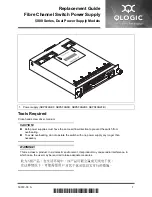
- 14 -
The following directions will give the inexperienced operator a start on common drill press
operations. Use scrap material for practice to get the feel of the machine before attempting
regular work.
CORRECT DRILLING SPEEDS
Factors which determine the best speed to use in any drill press operations are:
Type of material being worked,
Size of hole,
Type of drill or other cutter,
Quality of cut desired.
The smaller the drill, the greater the required r.p.m. In soft materials the speed should be
higher than for hard materials.
DRILLING METAL
Use clamps to hold the workpiece when drilling in metal. The workpiece should never be
held in the hand; the drill may snatch the workpiece at any time, especially when breaking
through. If the workpiece is twisted out of the operator’s hand, they may be injured.
The workpiece must be clamped firmly while drilling; any tilting, twisting or shifting results
not only in a rough hole, but also increases drill breakage. For flat work, lay the workpiece
on a wooden base and clamp it firmly down against the table to prevent it from moving. If
the workpiece is of irregular shape and cannot be laid flat on the table, it should be securely
blocked and clamped using vee-blocks, clamps or a machine vice.
OPERATION AND USE
WARNING: FOR YOUR OWN SAFETY ALWAYS TURN THE MAIN SWITCH ON THE MACHINE “OFF” AND
REMOVE THE PLUG FROM THE POWER SUPPLY BEFORE CARRYING OUT ANY MAINTENANCE OR
TROUBLESHOOTING.
TROUBLE SHOOTING
TROUBLE
Noisy Operation
Bit burns or smokes
Excessive drill run-out
or wobble
Drill binds in workpiece
PROBABLE CAUSE
1. Incorrect belt tension
2. Dry spindle
3. Loose spindle pulley or motor pulley
1. Incorrect speed
2. Swarf not coming out of hole
3. Blunt bit
4. Feeding too slow
5. Not lubricated
6. Bit running backwards
1. Bent bit
2. Worn spindle bearings
3. Bit not properly installed in chuck
4. Chuck not properly installed
1. Workpiece pinching bit or excessive
feed pressure
2. Improper belt tension
REMEDY
1. Adjust tension
2. Lubricate spindle with grease (ISO VG68)
3. Tighten set screws in pulleys
1. Change speed
2. Retract bit frequently to clear swarf
3. Sharpen or replace bit
4. Feed fast enough to allow drill to cut
5. Lubricate bit
6. Check motor rotation
1. Use a straight bit
2. Replace
3. Install bit centrally
4. Refit chuck properly
1. Support or clamp workpiece
2. Adjust tension






































